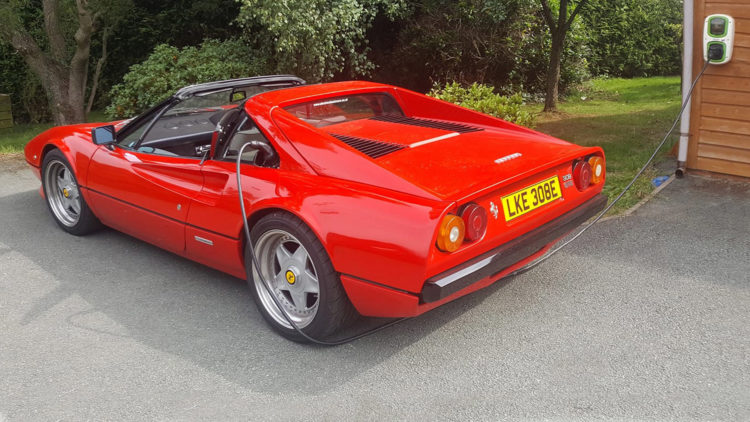The original article discusses the possibility of converting classic cars into electric vehicles (EVs) to combine the charm of a vintage car with the environmental benefits of an EV. It mentions two UK-based companies, Electric Classic Cars (ECC) and Electrogenic, that specialize in converting classic cars into EVs. The article highlights some of their notable conversions, such as a Ferrari 308 and a Rolls Royce Silver Shadow.
The article emphasizes the increasing restrictions on classic cars due to emissions regulations, such as London’s Ultra-Low Emission Zone. It explains that classic cars younger than a 1981 model year will be banned from certain areas unless a fee is paid. Converting classic cars to EVs offers a solution to this issue, allowing owners to enjoy their favorite vintage cars without emissions concerns.
The article also mentions the reliability and performance benefits of EV conversions. It suggests that EV conversions can make classic cars more reliable and enjoyable to drive. ECC and Electrogenic offer comprehensive conversion services, and almost any car can be converted into an EV.
The article concludes by emphasizing the growing interest in EV conversions and the unique driving experience they offer. It provides links to additional sections of the article that delve into finding a donor car, the cost of conversion, necessary components, and what it’s like to drive a classic car EV.
In summary, the article explores the concept of converting classic cars into EVs, highlighting the services offered by ECC and Electrogenic. It discusses the environmental benefits, driving experience, and the increasing popularity of EV conversions.
Converting Your Beloved Classic Car into an Electric Vehicle: A Step-by-Step Guide
Introduction:
Classic cars hold a special place in the hearts of many automobile enthusiasts due to their timeless design, rich history, and exhilarating driving experience. However, as the world moves towards a more sustainable future, the urge to convert these classic gas-guzzlers into eco-friendly electric vehicles becomes more prevalent. This step-by-step guide aims to assist those who wish to preserve the charm of their beloved classic car while embracing the green revolution by converting it into an electric vehicle.
Step 1: Research and Planning
The first step towards converting your classic car into an electric vehicle is thorough research and proper planning. Engage in extensive online research, consult experts in the field, and join relevant forums to gain insights into successful conversions. Determine the compatibility of your car’s make and model with electric conversion and research the specific parts required for the conversion process. Assess the feasibility of the conversion in terms of cost, time commitment, and availability of resources.
Step 2: Assessing the Chassis and Body
Before embarking on the conversion, it is vital to thoroughly inspect the chassis and body of your classic car. Look for rust or corrosion issues, as these can adversely affect the structural integrity of the vehicle. It is essential to address any necessary repairs or modifications at this stage, ensuring a solid foundation for the electric conversion.
Step 3: Removing the Powertrain
The powertrain, consisting of the engine, transmission, and exhaust system, must be removed from the classic car to make way for the electric components. This step requires careful disconnection of various mechanical and electrical components. It is crucial to label and document each step to ensure a smooth reassembly process.
Step 4: Installing the Electric Components
The heart of the electric conversion lies in the installation of the electric components, including the electric motor, batteries, controller, and charging system. This step demands meticulous attention to detail, ensuring that all components are installed correctly and securely. Seek expert guidance to ensure proper wiring, cable routing, and connection of these components, as they are critical for the safe and efficient functioning of the converted vehicle.
Step 5: Integration and Testing
Integration of the electric components with the classic car’s existing systems, such as the steering, brakes, and suspension, is an intricate process. Seek assistance from professionals with experience in electric conversions to ensure the seamless functioning and compatibility of these systems. Thorough testing is indispensable at this stage to identify any potential issues and rectify them promptly.
Step 6: Reassembling and Fine-tuning
Reassembling the classic car after the electric conversion is as important as the conversion process itself. Attention to detail is crucial, ensuring that each component is placed correctly and secure. Fine-tuning the suspension, alignment, and brakes is essential to guarantee the optimal driving experience and safety of the vehicle. Seek the expertise of skilled mechanics to fine-tune the converted car to its best performance.
Conclusion:
Converting your beloved classic car into an electric vehicle presents a unique opportunity to combine the charm of the past with the demands of a sustainable future. While the conversion process may seem daunting, this step-by-step guide emphasizes the importance of research, meticulous planning, and expert assistance to ensure a successful and reliable electric conversion. By following these steps, you can not only preserve the beloved classic car you cherish but also contribute to the global shift towards a greener automotive industry.

